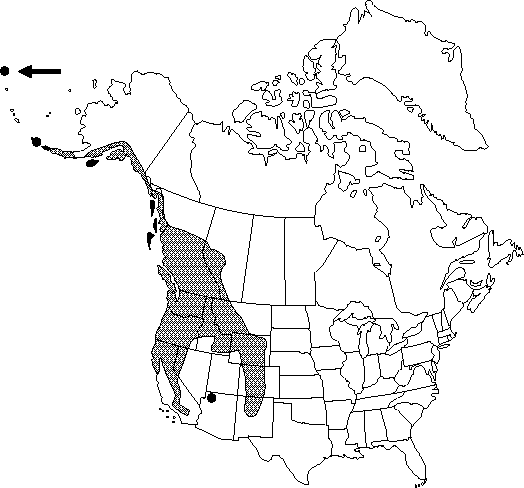Difference between revisions of "Ranunculus uncinatus"
in G. Don, Gen. Hist. 1: 35. 1831.
FNA>Volume Importer |
FNA>Volume Importer |
||
| Line 32: | Line 32: | ||
}}<!-- | }}<!-- | ||
| − | --><span class="statement" id="st- | + | --><span class="statement" id="st-undefined" data-properties=""><b>Stems </b>erect, never rooting nodally, hispid or glabrous, base not bulbous. <b>Roots</b> never tuberous. <b>Basal</b> leaf blades cordate to reniform in outline, 3-parted or sometimes 3-foliolate, 1.8-5.6 × 2.8-8.3 cm, segments again lobed, ultimate segments elliptic to lanceolate, margins toothed or crenate-toothed, apex acute to rounded-obtuse. <b>Flowers</b>: receptacle glabrous; sepals reflexed or sometimes spreading, 2-3.5 × 1-2 mm, pubescent; petals 5, yellow, 2-4(-6) × 1-2(-3) mm. <b>Heads</b> of achenes globose or hemispheric, 4-7 × 4-7 mm; achenes 2-2.8 × 1.6-2 mm, glabrous or sparsely hispid, margin forming narrow rib 0.1-0.2 mm wide; beak persistent, lanceolate, curved, hooked, 1.2-2.5 mm. <b>2n</b> = 28.</span><!-- |
-->{{Treatment/Body | -->{{Treatment/Body | ||
| Line 64: | Line 64: | ||
|publication year=1831 | |publication year=1831 | ||
|special status=Endemic | |special status=Endemic | ||
| − | |source xml=https://jpend@bitbucket.org/aafc-mbb/fna- | + | |source xml=https://jpend@bitbucket.org/aafc-mbb/fna-data-curation.git/src/9216fc802291cd3df363fd52122300479582ede7/coarse_grained_fna_xml/V3/V3_587.xml |
|genus=Ranunculus | |genus=Ranunculus | ||
|subgenus=Ranunculus subg. Ranunculus | |subgenus=Ranunculus subg. Ranunculus | ||
|section=Ranunculus sect. Ranunculus | |section=Ranunculus sect. Ranunculus | ||
|species=Ranunculus uncinatus | |species=Ranunculus uncinatus | ||
| − | |||
| − | |||
| − | |||
| − | |||
| − | |||
| − | |||
| − | |||
| − | |||
| − | |||
| − | |||
| − | |||
| − | |||
| − | |||
| − | |||
| − | |||
| − | |||
| − | |||
| − | |||
| − | |||
| − | |||
| − | |||
| − | |||
| − | |||
| − | |||
| − | |||
| − | |||
| − | |||
| − | |||
| − | |||
| − | |||
| − | |||
| − | |||
| − | |||
| − | |||
| − | |||
| − | |||
| − | |||
}}<!-- | }}<!-- | ||
-->[[Category:Treatment]][[Category:Ranunculus sect. Ranunculus]] | -->[[Category:Treatment]][[Category:Ranunculus sect. Ranunculus]] | ||
Revision as of 13:44, 27 July 2019
Stems erect, never rooting nodally, hispid or glabrous, base not bulbous. Roots never tuberous. Basal leaf blades cordate to reniform in outline, 3-parted or sometimes 3-foliolate, 1.8-5.6 × 2.8-8.3 cm, segments again lobed, ultimate segments elliptic to lanceolate, margins toothed or crenate-toothed, apex acute to rounded-obtuse. Flowers: receptacle glabrous; sepals reflexed or sometimes spreading, 2-3.5 × 1-2 mm, pubescent; petals 5, yellow, 2-4(-6) × 1-2(-3) mm. Heads of achenes globose or hemispheric, 4-7 × 4-7 mm; achenes 2-2.8 × 1.6-2 mm, glabrous or sparsely hispid, margin forming narrow rib 0.1-0.2 mm wide; beak persistent, lanceolate, curved, hooked, 1.2-2.5 mm. 2n = 28.
Phenology: Flowering spring–summer (Apr–Aug).
Habitat: Moist meadows or woods, often along streams
Elevation: 0-3400 m
Distribution

Alta., B.C., Alaska, Ariz., Calif., Colo., Idaho, Mont., Nev., N.Mex., Oreg., Wash., Wyo.
Discussion
Plants with hispid stems and achenes are often separated as Ranunculus uncinatus var. parviflorus; these two characters are poorly correlated, however, and sometimes vary between plants in a single collection. Ranunculus uncinatus was reported from northeastern Alberta and adjacent Northwest Territories by H. J. Scoggan (1978-1979, part 3). The specimens have hairy receptacles and straight, broad achene beaks; they apparently represent small individuals of R. macounii.
Some Native Americans used Ranunculus uncinatus as an antrirheumatic, a diaphoretic, a disinfectant, and an orthopedic aid, as well as in herbal steam baths intended to soothe sore muscles and rheumatism (D. E. Moerman 1986).
Selected References
None.